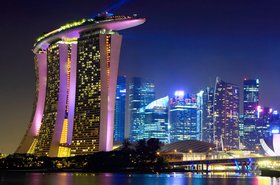Sustainability in the tropics is a highly challenging topic. With no cool outside air, ambient cooling is out even as more powerful chiller systems must be deployed to keep the hot and humid environment at bay all year around.
However, Kevin Wee, the APAC director for the data center vertical at Johnson Controls, feels that tightening the ratchet on sustainability is possible even in the tropics. Two options are to switch to less polluting energy sources, or to develop renewables in the form of hydroelectricity, solar, or geothermal energy, he told DCD in an interview..
Green in the city
But what about the data center hub of Singapore, a small island nation measuring 721 square kilometers and no access to a hinterland? With 95 percent of its energy requirements already met by natural gas, this also means that its energy mix is as clean as can be without turning to renewable energy – an area where it faces severe constrains.
“Though Singapore is not blessed with vast land or reserves of renewable energy, a more sustainable approach is still possible. From an O&M perspective, we feel that sustainability is highly applicable in Singapore,” said Wee. “Moreover, the government has also recognized the need to be more sustainable and is investing heavily in it.”
Late in 2019, the Singapore government announced an ambitious plan to increase its use of solar panels by seven times, and has committed close to $1 billion (US$718M) for research to explore renewable energy and carbon capture solutions, among others.
But colocation data centers are projected to take up a mammoth 600 megawatts (MW) of IT power by the middle of next year, which would seem to represent more than four percent of Singapore's total generation capacity of 13,700 MW. As new facilities come online, can data center efficiency move the needle on sustainability?
Hotter data centers
Actual energy consumption may be a murkier figure. Back in 2014, a study fond that data centers were then consuming some seven percent of Singapore’s electricity was consumed by data centers as far back as 2014 – the most recent year that this figure was made available. Overall energy consumption has grown only slightly since then, with percentage growth in the low single-digits annually. Meanwhie, data center capacity has grown significantly; if this has been accompanied by a reduction in the proportion of electricity used by the sector, it would be a testament to the increased efficiency of data centers.
However, even four percent of Singapore's energy is greedy, and sustainability efforts in the country are vital. Around the globe, it is generally reckoned that data centersuse about one percent of electricity on average.
Quoting data from Johnson Controls, Wee said that every one degree Celsius increase in chilled water temperature offers two to three percent savings in power consumption with a typical chiller. This increases to four to five percent for chillers fitted with a variable speed drive. Given the relatively high power consumption of data centers in Singapore, the numbers suddenly become highly compelling.
There are practical limits to how high the thermostat can be set, though. According to Wee, a sweet spot that many data center operators are exploring entails increasing temperatures to between 24 and 28 degrees Celsius, which translates to a chilled water temperature of between 16 and 18 degrees Celsius. Any higher, and this might impact the health of engineers and IT professionals working inside the facility, he explained.
So why are we not doing it?
So why are data centers not already operating at higher temperatures in Southeast Asia? One possibility mooted by Wee is that users in the region tend to be more conservative. For many, operating their data centers at a higher temperature is instinctively construed as placing the readiness and resilience of their IT infrastructure at heightened risk.
This is a moot point, however, said Wee, who argues that the technology today is very different from just five years ago. In the past, overall resilience is almost completely dependent on the reliability of a facility. Today, the cloud and pervasive virtualization now gives businesses the ability to shift resilience further up the stack, allowing properly architected workloads to easily traverse data centers for heightened robustness.
Unfortunately, a lot of the data centers requirements coming in today still call for low aisle temperatures, said Wee. This is particularly prevalent with enterprise IT deployments, and data center operators who don’t confirm to these specifications run the risk losing the business.
It was probably with this in mind that Singapore initiated research on a tropical data center back in 2016. Working with partners such as Hewlett Packard Enterprise and Huawei, the idea was to create a proof-of-concept to convince CIOs and data center managers that data center temperatures can be increased without harming either performance or reliability. (The trial was completed by end-2019, though there has been no formal announcements yet).
Making the change
For now, the onus is on data center operators to play their part and educate customers about the importance of sustainability, said Wee. Given that operators typically calculate the cost of cooling separately, operators can conceivably sweeten the deal by reflecting the shift to a higher aisle temperature in a discount in customers’ monthly bills.
“Operators can also do more education to their customers at large. It is one thing that I do not see enough of. I think there is a lot of opportunity for operators to come together to sing the same tune.”
It helps that data center competency is a lot higher today, with increased confidence and comfort by data center engineers and facility managers to push the boundaries, Wee said. “Across the industry, the talent pool has improved. There is very good maturity in terms of the talent and knowledge to know what to tweak to increase efficiency.”
Will regulations help on this front? After all, countries such as China have clamped down on data centers with a carbon footprint credit system for new data centers or imposing arbitrary PUE limits in some cities. So why not mandate a specific aisle temperature?
“I don’t think we are there yet, and I don’t think the Singapore government wants that to happen as well. Before we reach that point, the government is doing everything it could to help us be more sustainable,” said Wee. “The cost of [legislating data center temperatures], and the impact to businesses is going to be a lot larger, and it will be extremely disruptive. This is not something that anyone would want.”
But perhaps we don’t even need to get there.
“There are ample incentives for operators to improve their energy efficiency. Whether in terms of cooling efficiency, or improving the PUE, or even by further virtualizing IT workloads, all these translates to savings. If you decrease the PUE of a 1MW data center by 0.1, you are talking about US$125,000 of savings per year.”
Further reading
-

Broadcast DCD>Singapore 2020
-

-

Episode Tech Showcase - Day 3



